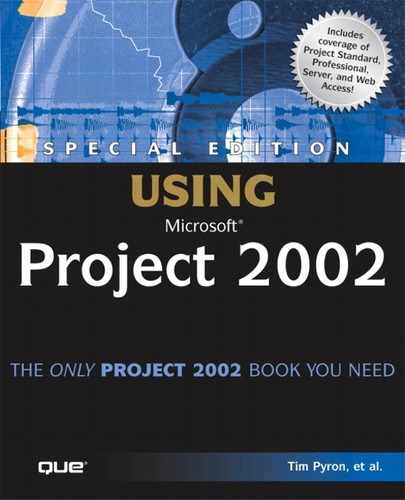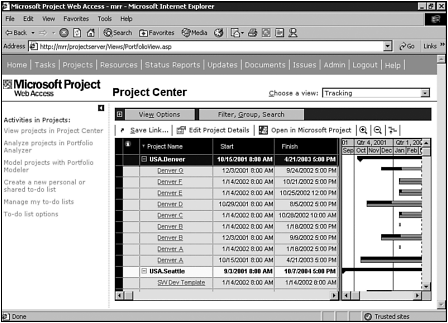Managing Views
As the Project Server administrator, you are responsible for creating and modifying the Project Center, Resource Center, and Portfolio Analyzer views and setting permissions for users to see these views.
The following sections provide information on creating and modifying Project Center and Resource Center views.
→ For details on creating or modifying Portfolio Analyzer views, see “Creating a Portfolio Analyzer View,” at www.quepublishing.com.
Creating and Modifying a Project Center View
 | To create a Project Center view, you need to select Admin, Manage Views, Add View and then select the Project Center radio button. |
To modify a Project Center view, you need to select Admin, Manage Views and then select the Project Center view that you want to modify and click Modify View.
The functionality and options associated with creating and modifying a Project Center view are identical, except that the view’s current configuration information is displayed when modifying a view.
For example, if you want to add the Location enterprise project outline code to the Project Work view, you need to perform the following steps:
1. | |
2. |
Select the Work view underneath Project Center and then click Modify View. The screen to add or modify a Project Center view is divided into six sections, as shown in Figure 28.2: Figure 28.2. You need to enter the information required to create a new Project Center view.
|
View Type— The view type is already set to the Project Center view when you are modifying a Project Center view. However, you need to select it if you are creating a new Project Center view.
View Name and Description— The view name must be unique. Pick a name that describes either the type of view or the view’s user(s), so that users can easily recognize the view in the Project Center screen. The Description field is accessible only to the administrator, and it can be used to define the view in more detail.
Fields— This section consists of two panes. The pane on the right side defines the Microsoft Project fields that are currently defined for the View. The left pane contains the list of Microsoft Project fields that are available for use in the view but have not yet been included. You can move fields between panes by selecting fields and clicking the Add, Remove, or Remove All buttons.
NOTE
Three fields—Project Name, Start, and Finish—are predefined for Project Center views and cannot be removed.
After the desired fields have been added to the Project Center view, you can change the sequence in which the fields are displayed in the view by using the Up and Down buttons.
The top field in the right-hand pane when you are defining the view will appear on the far left in the Project Center view, the second field from the top in the right-hand pane will appear second from the left, and so on, when the view is displayed.
To change the sequence of the fields, select a field in the right-hand pane and move it up or down on the list and click either Up or Down, as desired.
Gantt Chart Format— The Gantt Chart Format section allows you to choose the type of Gantt chart or custom Gantt chart you want to use to display information. The default Gantt chart value is Gantt Chart (Project Center). You can change this value by selecting the drop-down list box and selecting an alternative Gantt chart value.
Grouping Format— The Grouping Format section allows you to associate a unique grouping format with different views. You might want to do this to provide visual cues for users about the view that is being used. The default grouping value is timesheet. You can change this value by selecting the drop-down list box and choosing an alternative grouping value.
Categories (Optional)— You can control which users will be able to see and use the view by selecting and adding the desired categories. Users associated with categories that are defined as belonging to this view will then be able to see the view in the Project Center.
The Categories section consists of two panes. The pane on the right side defines the categories that the view currently belongs to. The left pane contains the list of available categories. You can move categories between panes by selecting categories and clicking the Add, Add All, Remove, or Remove All buttons.
3. |
Select Enterprise Project Outline Code1 from the list of available fields. (This is Elkhart Software Company’s Location code. The enterprise project outline code you choose may be different.) Click Add. |
4. |
Select Enterprise Project Outline Code1 at the bottom of the list of displayed fields, and click the Up button as many times as necessary to move the code where you want it to display in the project view. |
5. |
Click Save Changes. |
6. |
In Web Access navigate to Project Center and make sure the Work view is selected. |
7. |
Select the Filter, Group, Search tab, and from the Group By pull-down list, select Location. Your projects should now be grouped by location, as shown in Figure 28.3. Remember that your enterprise project outline codes may be named differently than the codes shown in the figure. Figure 28.3. Data (Work, for example) will roll up in the way it is grouped.
|
NOTE
You can use the horizontal scrollbar in the Tracking view to find newly added enterprise project outline code. Remember that you can change the column placement by using the Up and Down buttons in the Modify Views page (where you add or modify fields within a view).
Creating or Modifying a Resource Center View
To modify a Resource Center view, you need to select Admin, Manage Views, and then select the Resource Center view that you want to modify and click Modify View.
The functionality and options associated with creating and modifying a Resource Center view are identical, except that the view’s current configuration information is displayed when you are modifying a view.
To create or modify a Resource Center view, follow these steps:
1. |
Using Web Access, log on to Microsoft Project Server as the administrator and select the Admin tab. |
2. |
Select Manage Views from either the main screen or the sidepane. |
3. |
To add a new Resource Center view, select Add, and then select the Resource Center radio button. To modify an existing Resource View, locate the view in the list, select the view, and click Modify. The screen to add or modify a Resource Center View is divided into six sections, as shown partially in Figure 28.4: Figure 28.4. You need to provide the information required to create a Resource Center view.
|
4. |




